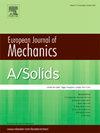Bending performance and crack propagation in biomimetic honeycomb structures for sustainable lightweight design
IF 4.4
2区 工程技术
Q1 MECHANICS
引用次数: 0
Abstract
In response to global resource shortages and environmental crises, lightweight design and resource-efficient utilization have emerged as pivotal technologies. This study innovatively introduces Fractal theory, which breaks the traditional paradigm of optimizing homogeneous materials, and establishes in 3D printed honeycomb structures a quantitative mapping relationship between crack propagation paths and fractal dimensions. The investigation focuses on 6 mm hexagonal honeycomb units, along with 5 mm and 10 mm square variants, exploring their drone design applications based on size-specific energy absorption characteristics. Using Fused Deposition Modeling (FDM) technology, we manufactured polylactic acid (PLA) honeycomb samples with hexagonal (Hex6) and square (Sq5, Sq10) topologies, with their mechanical responses characterized through quasi-static bending tests. Experimental results demonstrate that the hexagonal structure exhibits a unique multi-stage energy dissipation mechanism, showing 2.7% and 21.0% higher energy absorption capacity (0.7031 ± 0.0296 MJ/m3) compared to Sq5 (0.6847 ± 0.1213 MJ/m3) and Sq10 (0.5812 ± 0.0666 MJ/m3), respectively. Fractal analysis further reveals that Hex6's crack path fractal dimension (D Hex6 = 1.4121 ± 0.0361) significantly exceeds those of Sq5 (1.4052 ± 0.0316) and Sq10 (1.3911 ± 0.0324). These findings resolve the longstanding ambiguity between structural performance and failure mechanisms in existing research, establishing a bio-inspired lightweight design framework that synergistically integrates geometric configuration, manufacturing processes, and mechanical performance for multidimensional optimization.
求助全文
约1分钟内获得全文
求助全文
来源期刊
CiteScore
7.00
自引率
7.30%
发文量
275
审稿时长
48 days
期刊介绍:
The European Journal of Mechanics endash; A/Solids continues to publish articles in English in all areas of Solid Mechanics from the physical and mathematical basis to materials engineering, technological applications and methods of modern computational mechanics, both pure and applied research.

 求助内容:
求助内容: 应助结果提醒方式:
应助结果提醒方式:


